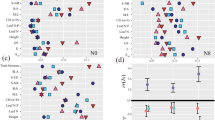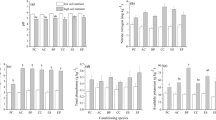Abstract
The EICA hypothesis predicts that shifts in allocation of invasive plants give rise to higher growth rates and lower herbivore defense levels in their introduced range than conspecifics in their native range. These changes in traits of invasive plants may also affect ecosystem processes. We conducted an outdoor pot experiment with Chinese tallow tree (Sapium sebiferum, Euphorbiaceae) seedlings from its native (Jiangsu, China, native ecotype) and introduced ranges (Texas, USA, invasive ecotype) to compare their relative performances in its native range and to examine ecotype effects on soil processes with and without fertilization. Consistent with predictions, plant (shoot and root) mass was significantly greater and leaf defoliation tended to be higher, while the root:shoot ratio was lower for the invasive ecotype relative to the native ecotype. Seasonal amounts of soil–plant system CO2 and N2O emissions were higher for the invasive ecotype than for the native ecotype. Soil respiration rates and N2O emission increases from fertilization were also greater for the invasive ecotype than for the native ecotype, while shoot-specific respiration rates (g CO2–C g−1 C day−1) did not differ between ecotypes. Further, soil inorganic N (ammonium and nitrate) was higher, but soil total N was lower for soils with the invasive ecotype than soils with the native ecotype. Compared with native ecotypes, therefore, invasive ecotypes may have developed a competition advantage in accelerating soil processes and promoting more nitrogen uptake through soil–plant direct interaction. The results of this study suggest that soil and ecosystem processes accelerated by variation in traits of invasive plants may have implications for their invasiveness.





Similar content being viewed by others
References
Allison DA, Vitousek PM (2004) Rapid nutrient cycling in leaf litter from invasive plants in Hawaii. Oecologia 141:612–619
Aulakh MS, Doran JW, Walter DT, Mosier AR, Francis DD (1991) Crop residue type and placement effects on denitrification and mineralization. Soil Sci Soc Am J 55:1020–1025
Baruch Z, Goldstein G (1999) Leaf construction cost, nutrient concentration, and net CO2 assimilation of native and invasive species in Hawaii. Oecologia 121:183–192
Belnap J, Phillips SL (2001) Soil biota in an ungrazed grassland: response to annual grass (Biomus tectorum) invasion. Ecol Appl 11:1261–1275
Blank RR, Young JA (2004) Influence of three weed species on soil nutrient dynamics. Soil Sci 169:385–397
Blossey B, Nötzold R (1995) Evolution of increased competitive ability in invasive nonindigenous plants: a hypothesis. J Ecol 83:887–889
Bossdorf O, Auge H, Lafuma L, Rogers WE, Siemann E, Prati D (2005) Phenotypic and genetic differentiation in native versus introduced plant populations. Oecologia 144:1–11
Bruce KA, Cameron GN, Harcombe PA, Jubinsky G (1997) Introduction, impact on native habitats, and management of a wood invader, the Chinese tallow tree, Sapium sebiferum (L.) Roxb. Nat Areas J 17:255–260
Coley PD, Bryant JP, Chapin III FS (1985) Resource availability and plant antiherbivore defense. Science 230:895–899
Davis MA, Pelsor M (2001) Experimental support for a resource-based mechanism model of invisibility. Ecol Lett 4:421–428
Davis MA, Grime JP, Thompson K (2000) Fluctuating resources in plant communities: a general theory of invasibility. J Ecol 88:528–534
DeWalt SJ, Denslow JS, Hamrick JL (2004) Biomass allocation, growth, and photosynthesis of genotypes from the native and introduced ranges of the tropical shrub Clidemia hirta. Oecologia 138:521–531
Duda JJ, Freeman DC, Emlen JM, Belnap J, Kitchen SG, Zak JC, Sobek E, Tracy M, Montante J (2003) Differences in native soil ecology associated with invasion of the exotic annual chenopod, Halogeton glomeratus. Biol Fertil Soils 38:72–77
Dukes JS, Mooney HA (2004) Disruption of ecosystem processes in western North America by invasive species. Rev Chil Hist Nat 77: 411–437
Durand LZ, Goldstein G (2001) Photosynthesis, photoinhibition, and nitrogen use efficiency in native and invasive tree ferns in Hawaii. Oecologia 126:345–354
Ehrenfeld JG (2003) Effect of exotic plant invasion on soil nutrient cycling processes. Ecosystems 6:503–523
Ehrenfeld JG, Scott N (2001) Invasive species and the soil: Effects on organisms and ecosystem processes. Ecol Appl 11:1259–1260
Ehrenfeld JG, Koutev P, Huang W (2001) Changes in soil functions following invasions of exotic understorey plants in deciduous forests. Ecol Appl 11:1287–1300
Elberse IAM, Turin JHB, Wäckers FL, Van Damme JMM, Van Tienderen PH (2003) The relationship between relative growth rate and susceptibility to aphids in wild barley under different nutrient levels. Oecologia 137:564–571
Elton CS (1958) The ecology of invasion by animals and plants. Chapman and Hall, London
Evans RD, Rimer R, Sperry L, Belnap J (2001) Exotic plant invasion alters nitrogen dynamics in an arid grassland. Ecol Appl 11:1301–1310
Flessa H, Beese F (1995) Effect of sugarbeet residues on soil redox potential and nitrous oxide emission. Soil Sci Soc Am J 59:1044–1051
Hawkes CV, Wren IF, Herman DJ, Firestone MK (2005) Plant invasion alters nitrogen cycling by modifying the soil nitrifying community. Ecol Lett 8:976–985
Hobbie SE, Gough L (2004) Decomposition in moist acidic and non-acidic tundra with different glacial histories. Oecologia 140:113–124
Huang Y, Jiao Y, Zong LG, Wang YS, Sass RL (2002) Nitrous oxide emissions from the wheat-growing season in eighteen Chinese paddy soils: an outdoor pot experiment. Biol Fertil Soils 36:411–417
Huang Y, Zou JW, Zheng XH, Wang YS, Xu XK (2004) Nitrous oxide emissions as influenced by amendment of plant residues with different C:N ratios. Soil Biol Biochem 36:973–981
Huxman TE, Cable JM, Ignace DD, Eilts JA, English NB, Weltzin J, Williams DG (2004) Response of net ecosystem gas exchange to a simulated precipitation pulse in a semi-arid grassland: the role of native versus non-native grasses and soil texture. Oecologia 141:295–305
Levine JM, Vilà M, D’Antonio CM, Dukes JS, Grigulis K, Lavorel S (2002) Mechanisms underlying the impacts of exotic plant invasions. Proc R Soc Lond B Biol 270:775–781
Lodge DM (1993) Biological invasions: lessons for ecology. Trends Ecol Evol 8:133–137
Kourtev PS, Ehrenfeld JG, Häggblom M (2003) Experimental analysis of the effect and native plant species on the structure and function of soil microbial communities. Soil Biol Biochem 35:895–905
Mack MC, D’Antonio CM, Ley R (2001) Alteration of ecosystem nitrogen dynamics by exotic plants: a case study of C4 grasses in Haiwaii. Ecol Appl 11:1323–1335
McDowell SCL (2002) Photosynthetic characteristics of invasive and noninvasive species of Rubus (Rosaceae). Am J Bot 89:1431–1438
Nagel JM, Griffin KL (2004) Can gas-exchange characteristics help explain the invasive success of Lythrum salicaria? Biol Invasions 6:101–111
Rogers WE, Siemann E (2004) Invasive ecotypes tolerate herbivory more effectively than native ecotypes of the Chinese tallow tree Sapium sebiferum. J Appl Ecol 41:561–570
Rogers WE, Siemann E (2005) Herbivory tolerance and compensatory differences in native and invasive ecotypes of Chinese tallow tree (Sapium sebiferum). Plant Ecol 181:57–68
Scott NA, Saggar S, McIntosh PD (2001) Biogeochemical impact of Hieracium invasion in New Zealand’s grazed tussock grasslands: sustainability implications. Ecol Appl 11:1311–1322
Siemann E, Rogers WE (2001) Genetic differences in growth of an invasive tree species. Ecol Lett 4:514–518
Siemann E, Rogers WE (2003a) Herbivory, disease, recruitment limitation and success of alien and native tree species. Ecology 84:1489–1505
Siemann E, Rogers WE (2003b) Reduced resistance of invasive varieties of the alien tree Sapium sebiferum to a generalist herbivore. Oecologia 135:451–457
Siemann E, Rogers WE (2003c) Increased competitive ability of an invasive tree may be limited by an invasive beetle. Ecol Appl 13:1503–1507
Simberloff D (1996) Impacts of introduced species in the United States. Conseq Nat Impli Environ Change 2:13–22
Tilman DT (2000) Causes, consequences and ethics of biodiversity. Nature 405:208–211
Vitousek PM (1990) Biological invasions and ecosystem processes towards an integration of population biology and ecosystem studies. Oikos 57:7–13
Vitousek PM, D’Antonio CM, Loope LL, Rejmanek M, Westbrooks R (1997) Introduced species: a significant component of human-caused global change. NZ J Ecol 21:1–16
Wang YS, Wang YH (2003) Quick measurement of CH4, CO2 and N2O emissions from a short-plant ecosystem. Adv Atmos Sci 20:842–844
Wolfe BE, Klironomos JN (2005) Breaking new ground: soil communities and exotic plant invasion. Bioscience 55:477–487
Zou JW, Huang Y, Zheng XH, Wang YS, Chen YQ (2004) Static opaque chamber-based technique for determination of net exchange of CO2 between terrestrial ecosystem and atmosphere. Chin Sci Bull 49:381–388
Zou JW, Huang Y, Sun WJ, Zheng XH, Wang YS (2005) Contribution of plants to N2O emissions in soil-winter wheat ecosystem: pot and field experiments. Plant Soil 269:205–211
Acknowledgments
We thank Yao Huang, Lianggang Zong, Yanyu Lu, Shutao Chen and Jun Lu for their help in collecting seeds and taking emission samples, and the US National Science Foundation (DEB-0315796) for support. We are grateful to two anonymous reviewers for their helpful comments that have greatly improved the quality of this manuscript.
Author information
Authors and Affiliations
Corresponding author
Additional information
Communicated by Mercedes Bustamante
Rights and permissions
About this article
Cite this article
Zou, J., Rogers, W.E., DeWalt, S.J. et al. The effect of Chinese tallow tree (Sapium sebiferum) ecotype on soil–plant system carbon and nitrogen processes. Oecologia 150, 272–281 (2006). https://doi.org/10.1007/s00442-006-0512-2
Received:
Accepted:
Published:
Issue Date:
DOI: https://doi.org/10.1007/s00442-006-0512-2




